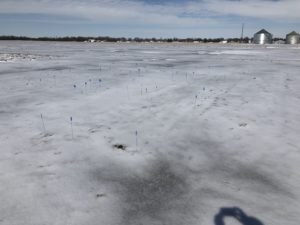The Winter of 2018-2019 will go down in history as one of the coldest and wettest winters ever in parts of the Midwest. While we didn’t get hit with all 24 of the named winter storms, we did have run-ins with Bruce, Carter, Gia, Harper, Indra, Jayden, Lucian, Maya I, Oren, Petra and Scott. On top of that came numerous Polar Vortexes and a bomb cyclone or two.
February in particular was remarkably brutal with heavy rain, sleet and ice on top of frozen ground. This combination of precipitation resulted in several inches of ice that stuck around well into March and suffocated vegetation. It was one of the worst winters for killing pastures and alfalfa fields many could remember. The Grassland Oregon Richland, IA Research Farm was under 3-4” of ice from early February until the second week of March. The outcome was not pretty.

Let’s take a look at what was planted last fall and how it came thru the winter.
Towards the end of August 2018, we were in the midst of a hot, dry spell and I was beginning to think it may never rain again so I decided I better get started on my fall projects early. On August 28th I planted my bio strip plot. I planted rows of Driller Radish, Oats and Buckwheat 6” apart with the next series of these species starting 36” later. These species would all winter-kill.



In a 12” strip between the winter-kill crops, I planted clovers. Four replications each of AberLasting Hybrid Clover, FIXatioN Balansa Clover and Kentucky Pride Crimson Clover were utilized. The plan was to plant sweet corn between the Driller Radish and Buckwheat the following Spring. The residue from the winter-killed crops would “bio-till” the soil and the residue would help suppress weeds and hold in moisture. The clover would hopefully survive and help to suppress weeds then give the corn it’s nitrogen when they reached the end of their life cycle in May.

The winter-kill species did their job and it was like planting the corn into butter in April. AberLasting made it through the winter unscathed. So much so that I realized I had planted it too heavily. Once warm weather arrived, the clover spread out and competed with the corn. This area of the farm was under ice for 5 weeks and it took a toll on the FIXatioN and Kentucky Pride. In early April it looked like most of it had been suffocated but 4 weeks later, I had all the FIXatioN I could handle. It’s amazing how many times we hear from a farmer that his FIXatioN didn’t make it thru the winter then a couple weeks later, they call back and say, “Holy Smokes, that clover is everywhere!” I got to see that happen first hand this year. The Sweet Corn in this plot doesn’t look too good but if you live in the Midwest, you wouldn’t expect it to. May and much of June were extremely wet and cool which is not good weather for growing corn.

On September 11, 2018 I planted large blocks of our annual legumes. FIXatioN Balansa Clover, Frosty Berseem Clover, Kentucky Pride Crimson Clover, a couple experimental Persian Clover lines, Survivor Winter Peas as well as common Hairy Vetch and Dixie (VNS) Crimson Clover. Our growing season in Iowa ended early and abruptly with cold weather arriving in early October but not before the legumes were well established and ready to take on the winter weather. These blocks of clovers were under a 3” sheet of ice for 5 weeks and it wreaked havoc on them. 90% of the Hairy Vetch was killed, 70% of the Kentucky Pride was killed, all of the Dixie (VNS) suffocated, and Frosty was gone (not that unusual as it only survived down to about 15*F). FIXatioN fared the best of all but even it was only about a 50% stand. This was the first year in the 5 years I have been growing FIXatioN that it had any noticeable winter kill.

Frost Seeding trials were on deck for February 2019 but without my hockey skates, I wasn’t going to get anything planted. On March 18th, the ground was finally clear of ice and I frost-seeded Red Clover and Frosty Berseem Clover. Frosty lived up to its name and looked phenomenal.


By June 27 it was 18” tall and had suppressed the weeds that wanted to consume the farm as usual. Alfalfa fields that were frost-seeded with Frosty Berseem last spring definitely paid dividends to farmers who had winter-kill difficulties in their fields.

We are now in the dog days of summer with temperatures in the mid 90’s, dew points in the 70’s and summer annual weeds stretching their legs. We have perfect conditions for foliar diseases so I am paying close attention to our space plant nursery of new turf and forage candidates to see which ones will do best in these trying conditions.
Enjoy the rest of the summer!
For a printable, PDF version of this blog, click below.

